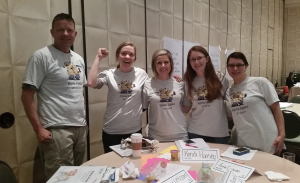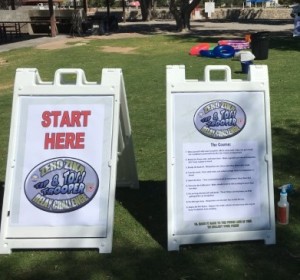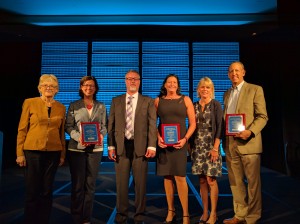By Anastasia Sonneman, NACCHO Communications Specialist
This story originally ran on NACCHO’s Preparedness Brief.
The year 2016 brought a whole new meaning to the importance of public health emergency preparedness. From the onset of Zika virus disease to international acts of violence related to terrorism, to the worst global migrant crisis since World War II, NACCHO has worked diligently in collaboration with many of its members and partners to enhance the capacity of local health departments (LHDs) to protect and increase the resiliency of their communities. As we enter the new year, many of NACCHO’s preparedness-related projects can still serve as a valuable resource to local preparedness staff. With this in mind, the NACCHO Preparedness team compiled the following list, highlighting a selection of the year’s featured programs, events, resources, and tools.
2016 Programs & Events
Preparedness Summit Draws Highest Attendance Since 2011
April 2016 marked the 10th annual NACCHO Preparedness Summit, the first and longest-running national conference on public health preparedness. Convening nearly 2,000 participants, a record high across the past five years, the four-day event addressed the theme of “Planning Today for Rebuilding Tomorrow: Resiliency and Recovery in the 21st Century.” A total of 145 workshops, 100 poster presentations and 59 exhibitors delivered a diverse range of hands-on learning opportunities, cross-cutting research, best practices, interactive discussions and more, inspiring attendees to gain new insight on community resilience and recovery.
LHD preparedness staff are highly encouraged to take advantage of the 2017 Preparedness Summit, taking place on April 25-28 in Atlanta Georgia. Early bird registration is now open offering reduced rates through February 14, 2017.
Roadmap to Ready Trains Second Cohort of Preparedness Workforce
 In 2016, NACCHO hosted its second cohort of Roadmap to Ready, a training and mentoring program to help new emergency preparedness coordinators navigate the complex landscape of public health preparedness. The yearlong program pairs new coordinators with experienced preparedness staff who guide and support them through a series of training and networking opportunities. After a successful first year, the total number of 2016 program participants grew by 14 percent, recruiting a higher number of both new coordinators and experienced staff to serve as their mentors. This year’s group also represented a broader range of local health departments, covering all ten HHS regions and 27 states.
In 2016, NACCHO hosted its second cohort of Roadmap to Ready, a training and mentoring program to help new emergency preparedness coordinators navigate the complex landscape of public health preparedness. The yearlong program pairs new coordinators with experienced preparedness staff who guide and support them through a series of training and networking opportunities. After a successful first year, the total number of 2016 program participants grew by 14 percent, recruiting a higher number of both new coordinators and experienced staff to serve as their mentors. This year’s group also represented a broader range of local health departments, covering all ten HHS regions and 27 states.
To learn more about Roadmap to Ready Program and how to apply as a mentee or mentor, visit the NACCHO website.
National Preparedness Month Promotes Innovation and Engagement
Each September, as part of National Preparedness Month, preparedness efforts across the country are celebrated and highlighted. In collaboration with the CDC, NACCHO recruited LHDs and Medical Reserve Corps (MRC) Units to take the “Preparedness Pledge,” by making a commitment to conduct preparedness activities throughout the month. Overall, a total of 13 LHDs and 5 MRCs from 14 states pledged to conduct preparedness activities throughout the month. Whether engaging families, middle school students, pet owners, or volunteers, local health departments and MRC units alike used innovation and creativity to generate community interest about being prepared in an emergency. For example, the City of El Paso Department of Public Health organized a Zika awareness relay race to educate families on ways to prevent mosquito bites and breeding sites. Click to read more about highlights from this year’s pledge participants.
September 2017 is closer than it may seem and it’s never too early to start planning for Preparedness Month! Look for announcements on how to take the pledge on this blog and social media next summer.
Project Public Health Ready Recognizes Exemplary Preparedness Work
Now in its 12th year, NACCHO’s Project Public Health Ready (PPHR) continued to support LHD capacity and capability to plan for, respond to, and recover from public health emergencies. Each year LHDs apply for PPHR recognition by submitting documentation for national review by local preparedness subject matter experts from across the country. In 2016, another 67 local and regional agencies achieved PPHR recognition for their exceptional ability to plan for, respond to, and recover from public health emergencies. Since 2004, over 450 organizations have been PPHR-recognized for their achievements in public health preparedness.
To learn more about PPHR and how to become a National Reviewer or applicant jurisdiction, please visit the NACCHO website.
2016 Tools & Resources
Strengthening Local Response Capacity to Zika and Other Emerging Threats
Throughout 2016, Zika emerged as a serious global threat with unpredictable consequences. With public health in the U.S. at risk, NACCHO – in close coordination with the Centers for Disease Control and Prevention (CDC) – dedicated more than 1,350 staff hours to identify, develop, and maintain tools, resources, and partnerships that enabled LHDs to prepare for the impact of the Zika virus. LHD staff will find three resources particularly useful to gather the latest information on Zika and to advocate for local preparedness capacity and other unforeseen public health emergencies in the future.
- Zika Resources Microsite: This digital channel is designed to inform local health departments with real-time updates addressing any news, tools, and guidance related to the Zika virus. The site is regularly updated by NACCHO staff with the most recent Zika developments, reports, and LHD developed projects.
- Zika Funding Report & Infographic: Developed to illustrate results of the impact survey conducted by NACCHO, the Association of State and Territorial Health Officials (ASTHO), Council of State and Territorial Epidemiologists (CSTE), and Association of Public Health Laboratories (APHL), this report and complementary infographic demonstrate limited LHD response capacity resulting from public health emergency preparedness (PHEP) funding cuts and other resource constraints. Both were crucial to NACCHO advocacy efforts, ultimately resulting in congressional allocation of additional federal funding for Zika response. Similarly, LHDs can leverage this report and infographic along with local data when advocating for increased PHEP funding for their jurisdictions.
- PHEP Communication Toolkit: Developed by ASTHO with consultation from NACCHO to advance health department advocacy efforts in support of local PHEP funds, this toolkit includes guidelines and real-life examples to inform state, local, and territorial preparedness staff on how to best approach a tailored communication strategy when promoting their agency’s need for PHEP funding to community decision-makers, legislators, and other stakeholders.
Promoting National Health Security Strategy at the Local Level
NACCHO recognizes the growing significance of translating national health security strategy (NHSS) into the local context and has continued to work with the Department of Health and Human Services’ Office of the Assistant Secretary for Preparedness and Response (ASPR) to promote local health preparedness work in this area. In 2016 NACCHO and ASPR partnered on two key initiatives empowering local health department to improve health security and resilience in their communities.
- National Health Security Awards Program: Now in its second year, this award program recognizes five local health departments for exemplary achievements corresponding with one of ASPR’s five strategic objectives for national health security. By formally honoring the selected LHDs at NACCHO Annual, NACCHO and ASPR aim to encourage recipients to continue their health security work, while inspiring their peers to replicate similar efforts in their own communities. Although the 2016-17 application period is now closed, LHDs are encouraged to view this year’s award announcement blog for more about how to apply in anticipation for next year.
- National Health Security Strategic Messaging Guide: Developed by NACCHO and ASPR to help local health departments understand and effectively communicate their roles in health security to external stakeholders, this guide includes specific steps local health preparedness staff need to take when developing messaging about national health security, as well as stories from the field featuring best practices in relevant topic areas.
Increasing Local Capacity for Radiation Response
Radiation preparedness is no longer just a necessity for jurisdictions neighboring nuclear facilities. In fact, there is concern from experts that the threat of a radiological emergency is growing across the nation. In order to aid local jurisdictions and other key stakeholders with radiation preparedness efforts, NACCHO released several new resources in 2016:
- Radiation Toolkit: This toolkit houses the many radiation resources available to public health and emergency management professionals, and can be accessed by visiting the NACCHO Toolbox and selecting “Radiation Toolkit” in the toolkits dropdown menu). It includes documents detailing the many aspects of radiation preparedness, links to helpful trainings, and related organizational websites.
- Radiological Sheltering Tabletop Exercise Toolkit: Designed by NACCHO in collaboration with the CDC, this toolkit aids in effective assessment of radiation preparedness considerations needed for the sheltering of evacuees from an impacted community. Piloted by five local jurisdictions, this toolkit offers tabletop exercises compliant with the CDC 2015 Guide to Operating Public Shelters in a Radiation Emergency and Homeland Security Exercise and Evaluation program (HSEEP), specifically refined for LHD use.
Ensuring Access to PHEP Resources at the Local Level
As LHDs strive to achieve and enhance community preparedness, response, and recovery capacity and capability, they are often faced with searching through hundreds of randomly assorted tools across a wide range of sources. In an effort to create a more seamless resource-gathering process for public health professionals, NACCHO, in collaboration with the CDC, offers two resource portfolios made up of key tools and resources on each of the 15 CDC public health preparedness (PHEP) capabilities.
- PHEP Resource Portfolios: a combination of toolkits, guidance documents, templates, and links to exemplary programs for each topic area is available in two comprehensive collections. Resources for Capabilities 1, 6, 8, 9, and 13 can be found via the 2014 volume of the PHEP resource portfolio, while this year’s newly released version covers the remaining ten capabilities. NACCHO encourages LHDs to reference both volumes one and two as a guide informing agency preparedness planning and exercises.
For more featured resources, tools, and upcoming events from the NACCHO Preparedness team and our partners, LHDs should regularly visit this blog and the NACCHO Public Preparedness webpage. Also, subscribe to NACCHO’s monthly Preparedness Brief digest newsletter and follow our Facebook and Twitter accounts for instant updates on the latest resources and other information.









